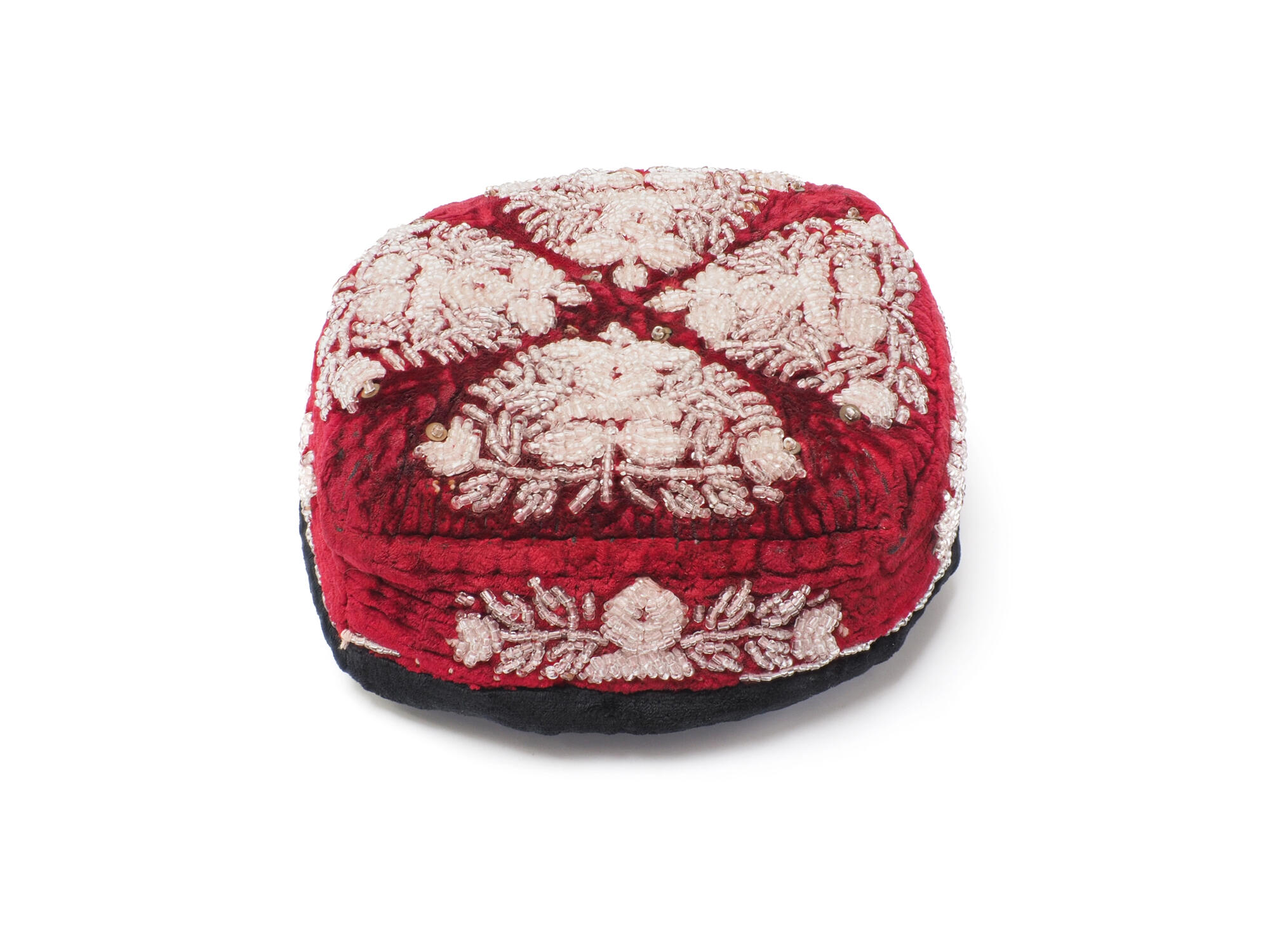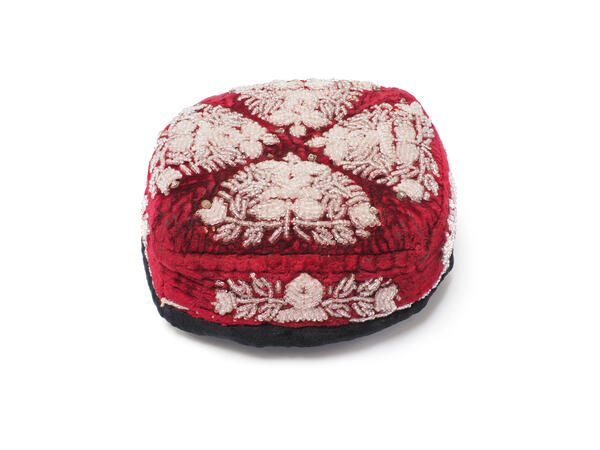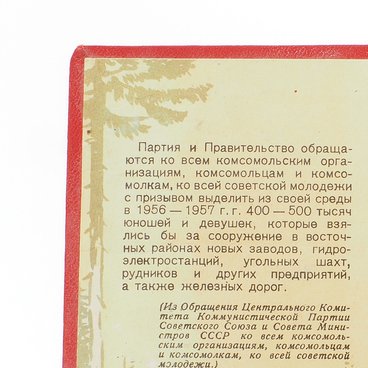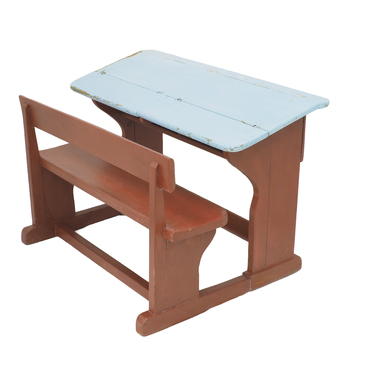The tubeteika is the national headdress of the Central Asian peoples. It is a round or square cap with a flat or domed top. TubetEikas are sewn from various fabrics and decorated with fine embroidery.
The headdress from the museum collection was made of dark red velvet. The upper part and the sides of the item have a floral and plant ornament embroidered with white beads. The color and ornament of the tubeteika reflect the peculiarities of life and traditions of the part of Asia where it was made. For the Central Asian peoples, the tubeteika was not only a headdress but also a talisman. It was worn on the top of the head and was considered to protect the most vulnerable place of the human body from evil spirits.
In the USSR, the 1950-60s were the time of Komsomol detachments and shock construction projects. At this time, new spaces were developed, cities were built, industrial zones expanded, and residential areas appeared. In May 1956, the Central Committee of the Communist Party of the Soviet Union and the Council of Ministers of the USSR adopted a Decree “On Measures to Provide Labor for the Most Important Construction Sites and Enterprises Located in the Eastern and Northern Regions of the Country and in the Donbas.” The implementation of this Decree was entrusted to the Komsomol organizations. About 500 thousand young men and women went to the Komsomol construction sites. Seversk representatives organized the recruitment of volunteers in Moscow and Leninabad (now the city of Khujand, Tajikistan).
The women’s tubeteika was donated to the museum by Lilia Emelyanova in October 2018 for the exhibition dedicated to the 100th anniversary of the All-Union Leninist Young Communist League.
Lilia Emelyanova (Nechaeva) was one of the first Komsomol construction workers who arrived in Seversk in August 1956. She was born in 1938 in the Moscow region. She graduated from the Asian Polytechnic and came on a Komsomol direction to build the city of Seversk. After the courses at the training center of the construction management, Yemelyanova worked as a laboratory assistant, as a foreman of the technical control department in the reinforced concrete products workshop (ZBI-1), and then as a technologist of the reinforcement workshop. From 1975 to 1984, she was a senior engineer, and later — the chief technologist of the combine. In 1983, Lilia Emelyanova retired. Her work experience was 43 years, 37 years of which she worked at “Khimstroy”.
Emelyanova bought a tubeteika before leaving Central Asia. She fondly recalled how she had specially sewn a dress for this headdress. For 60 years, Lilia Emelyanova kept the tubeteika at home — as a souvenir and a memory of the years of her life and study in Central Asia.
The headdress from the museum collection was made of dark red velvet. The upper part and the sides of the item have a floral and plant ornament embroidered with white beads. The color and ornament of the tubeteika reflect the peculiarities of life and traditions of the part of Asia where it was made. For the Central Asian peoples, the tubeteika was not only a headdress but also a talisman. It was worn on the top of the head and was considered to protect the most vulnerable place of the human body from evil spirits.
In the USSR, the 1950-60s were the time of Komsomol detachments and shock construction projects. At this time, new spaces were developed, cities were built, industrial zones expanded, and residential areas appeared. In May 1956, the Central Committee of the Communist Party of the Soviet Union and the Council of Ministers of the USSR adopted a Decree “On Measures to Provide Labor for the Most Important Construction Sites and Enterprises Located in the Eastern and Northern Regions of the Country and in the Donbas.” The implementation of this Decree was entrusted to the Komsomol organizations. About 500 thousand young men and women went to the Komsomol construction sites. Seversk representatives organized the recruitment of volunteers in Moscow and Leninabad (now the city of Khujand, Tajikistan).
The women’s tubeteika was donated to the museum by Lilia Emelyanova in October 2018 for the exhibition dedicated to the 100th anniversary of the All-Union Leninist Young Communist League.
Lilia Emelyanova (Nechaeva) was one of the first Komsomol construction workers who arrived in Seversk in August 1956. She was born in 1938 in the Moscow region. She graduated from the Asian Polytechnic and came on a Komsomol direction to build the city of Seversk. After the courses at the training center of the construction management, Yemelyanova worked as a laboratory assistant, as a foreman of the technical control department in the reinforced concrete products workshop (ZBI-1), and then as a technologist of the reinforcement workshop. From 1975 to 1984, she was a senior engineer, and later — the chief technologist of the combine. In 1983, Lilia Emelyanova retired. Her work experience was 43 years, 37 years of which she worked at “Khimstroy”.
Emelyanova bought a tubeteika before leaving Central Asia. She fondly recalled how she had specially sewn a dress for this headdress. For 60 years, Lilia Emelyanova kept the tubeteika at home — as a souvenir and a memory of the years of her life and study in Central Asia.



